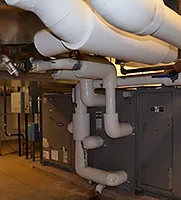Researchers at Penn State are investigating the use of ultraviolet germicidal irradiation as a long-term maintenance solution for cooling coils in commercial HVAC systems.
The research, conducted by William Bahnfleth, professor of architectural engineering, and alumnus Joseph Firrantello, is a field study that involves the installation of sensors to collect temperature, humidity, air flow and pressure drop data on HVAC cooling coils before and after UVGI was used to clean away the buildup of microorganisms. The project uses the data collected from the field research to create models that estimate the potential energy and indoor air quality benefits of UVGI cleaning.
During normal operation, heat transfer coils in HVAC systems become polluted with microorganisms — primarily fungi and bacteria and other particulate matter in the air. This buildup leads to a loss of performance, both in lost heat transfer capacity and through the increased energy consumption that is needed to continue to move air through the system. Heat transfer coils are particularly vulnerable to contamination because of the condensation that forms on them and the fins that make up the system
Ultraviolet irradiation is an alternative or adjunct to mechanical and chemical cleaning options. Bahnfleth said. UVGI systems are currently available from many manufacturers, but due to the lack of independent research and analysis to document the effectiveness of UVGI coil cleaning, its use is limited.
“UVGI has been used for water, air and surface disinfection for over 100 years, but applications to control indoor air quality have not been as well studied as they should, leading to questions about the effectiveness and safety of this technology,” Bahnfleth said. “Through our work, we hope to answer important questions about how well UVGI works under different conditions, when its use should be considered, and whether there are safety issues associated with its use that need to be addressed.”
In addition to calculating potential energy saving capabilities and IAQ benefits, the project also includes the continued monitoring of the research sites — HVAC systems located in two buildings. Sustaining these experiment sites allows for the collection of additional results, potentially leading to better application of the UVGI cleaning technology.
The work aligns with the ASHRAE Research Strategic Plan, as its results will help to “maximize the actual operational energy performance of buildings and facilities; support the development of improved HVACR components ranging from residential to commercial in order to provide improved system efficiency, affordability, reliability and safety; and better understand influences of HVACR on airborne pathogen transmission in public space and develop effective control strategies.”
“The ASHRAE Research Strategic Plan represents the current priorities of the built environment industry to solve the most pressing problems related to providing a high level of indoor environmental quality while minimizing impacts on the environment,” Bahnfleth said.
This research aims to provide the architectural engineering and building communities with a comprehensive analysis of the energy benefits of using UVGI to decrease the microorganism buildup on cooling coils, as well as an approach to use these results in a design application. Experimentally verified models have been developed to implement into practical design tools.
“Building designers and analyzers need to be able to predict the effects of their choices on significant aspects of building performance, in particular, indoor air quality, temperature and humidity and energy use,” Bahnfleth said. “User-friendly tools for modeling the indoor environment and predicting its impact on occupants — acute and chronic health effects and productivity — are not available today.”
The field measurements have provided real-world data on the improvements to system performance due to UVGI cleaning and information on the method used to measure these improvements. Data is being applied in a range of building energy models to measure potential energy and IAQ improvements.
“The most important function of buildings is to provide a safe, healthy, and productive environment for occupants. It is clear from a large body of research that it is possible to do better than we are today,” Bahnfleth said. “Conservation of energy and other resources, and reduction of environmental pollution, are important related objectives that need to be addressed in parallel. Until we can provide high-quality indoor environments to all in buildings that make efficient use of clean energy, there will be work to do."




